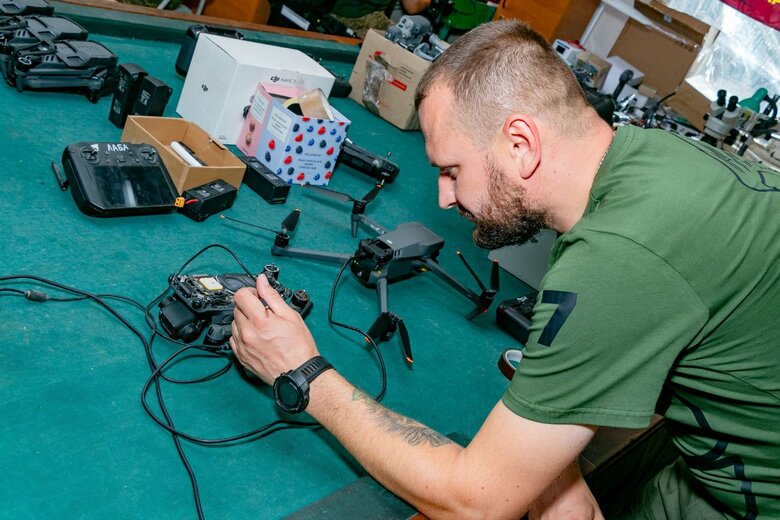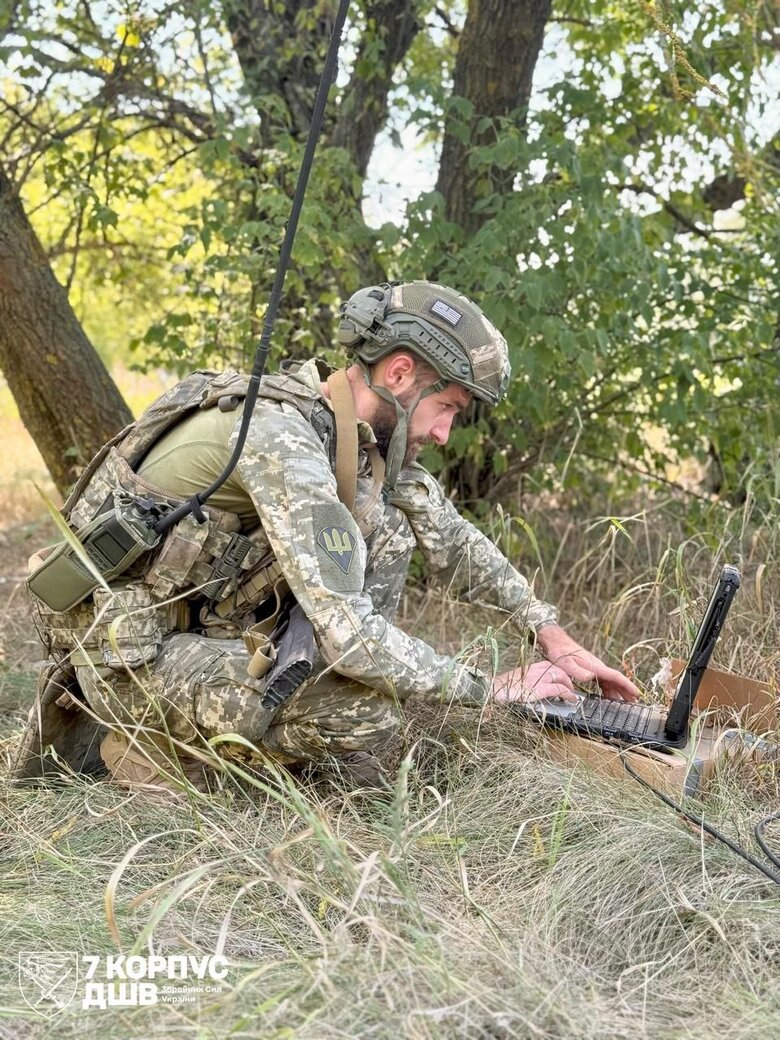Artificial intelligence and space technologies: How should EW systems evolve?
The war in Ukraine has long been dubbed by global media and experts as "the first drone war." In modern warfare, a multi-million-dollar tank can be taken out by five drones costing at most $3,000. A drone can now fly up to 50 km deep and paralyze logistics. Under these conditions, electronic warfare (EW) assets play a key role.

We asked Major Viktor Kordon, Chief of the Electronic and Cyber Warfare Section of the 7th Corps of the Air Assault Forces, who is currently defending Pokrovsk, about new solutions, challenges, and the development of electronic warfare systems.
- How have approaches to electronic warfare changed since the start of the full-scale invasion?
- Electronic warfare is a relatively new domain for the Armed Forces of Ukraine. Its development is closely tied to the evolution of the unmanned aerial vehicles (UAVs). In 2022, we were dealing with fairly rudimentary UAVs such as Orlan and Mavic. There was practically nothing else at the front. They operated on standard frequencies, and there were no FPV drones yet.
Starting in 2023, the enemy began employing Lancet strike UAVs, cruise missiles and guided aerial bombs (KABs) were fitted with the more advanced Kometa module, which significantly improved their resistance to navigation disruption. FPV drones emerged, but were still on standard frequencies. We then began deploying compact EW sets and anti-drone rifles at forward positions. The Air Assault Forces were the first to use cutting-edge EW assets.
The year 2024 marks a fundamentally new stage in EW development, the build-out of integrated systems. There was a significant breakthrough in the frequency-based approach to operating kamikaze drones. A very large number of new FPV drones appeared on both sides. We needed a comprehensive solution that would prevent the enemy from gaining an edge in the use of these systems. In 2024, the adversary also carried out to sweeping upgrade of fixed-wing UAVs such as ZALA and Orlan. We have had to rethink our methods for suppressing these UAVs.
- How did the corps-level reform affect the deployment of integrated electronic warfare measures?
-In 2024, after several experiments, we had a clear understanding that a corps-level combined EW and air-defense command post had to be the primary, key C2 node for EW assets and for coordinating friendly UAVs. Anything above corps level no longer provides detailed awareness of the current situation at the frontline, while anything below corps level does not yet achieve the necessary unity of effort. In my view, the corps-based system proved to be an effective solution to the situation we faced.
In 2024, we deployed the first combined EW and air-defense command post based on the 7th Corps of the Air Assault Forces. Over a year of operating the combined command post, we gained experience in overall command and control, established procedures for ingesting information from multiple sources, expanded our software toolkit, intensified process automation, and rolled out the Delta system within the EW domain.
- Which technology trends are currently having the greatest impact on EW development?
- In 2025, the dominant trend is the advance of artificial intelligence, which enables us to automate our work. We anticipate that, in the future, an EW system will treat the operator as a supervisor, because thanks to AI, we can build automatic detection systems that will detect signals, recognize the target, and automatically activate EW assets without creating interference for our own UAVs.
- Could you describe how EW units interact with other branches?
- In the 7th Corps, effective cooperation is ensured through the deployment of a corps-level EW command post and by establishing EW duty officers at every echelon down to the battalion level. This allows us to maintain full situational awareness and respond in a timely manner. Thanks to the unified system, we can distribute EW forces and assets evenly across the corps, in line with each unit’s assigned tasks. We also work closely with all formations operating within the 7th Corps’ area of responsibility.
- What are the main challenges your section faces today?
- The core idea of the 7th Corps is unity of effort, bringing all EW assets together to work as one. The 7th Corps is now the nerve center. We do not confine ourselves to brigade sectors, we operate in a common framework for everyone. We provide continuous support to EW units, collect data on systemic issues, and always try to resolve those issues both through military means and in cooperation with civilian organizations.
- How do you assess personnel training and education in the EW domain?
- Training centers and military educational institutions do prepare the relevant specialists, but what they provide are, rather, general operating principles. High-end expertise is acquired in the field. At first, they take up duty as trainees, then gain experience and work independently, eventually passing their knowledge on to new comrades. It’s important to understand that EW knowledge is not a constant, it is quite literally refined every day, so personnel are continuously learning.
- How important is the role of civilian IT companies and specialist engineers in developing EW capabilities?
- It is very important. The quality of EW assets, like any product, depends on competition among civilian organizations. In seeking government contracts, civilian specialists strive to create something newer and better than anyone else. The principle at work is similar to the U.S. approach to defense contracting: a quality end product is possible only through open competition. Therefore, in my view, EW assets should be manufactured solely by civilian organizations, and there should be no single producer making the entire product line.
- Are there examples of successful EW employment you can share to illustrate the effectiveness of these systems?
- The 7th Corps is not newly formed. As a command element, it has been performing its tasks since late 2023. To illustrate the results, I can cite figures from the Donetsk axis in 2024.
Every day, the enemy employed 500–600 FPV drones against our units. Roughly 50 reached the vicinity of their targets. And fewer than 10 managed to hit what they had planned to strike. By our overall estimates, the enemy’s success rate with FPV drones was about 3–5%. This held steady through most of 2024. The number of drones increased, but the effectiveness remained essentially unchanged.
The same applies to enemy fixed-wing UAVs. When we assumed responsibility for our sector in spring 2024, enemy "wing-type" UAVs were able to fly 20–30 kilometers deep into our defenses. After several months of our intensive work, denying the enemy the ability to control its UAVs beyond the line of contact, coordinating with air defense, and shooting down hundreds of UAVs, the enemy began to think twice before crossing the line of contact.
At present, in the Pokrovsk sector, we have implemented the same approach, and it is already producing results. Fixed-wing UAVs are reluctant to go beyond the line of contact, and the number of FPV strikes is decreasing. But this is only the beginning: we have many further developments that we are continuously putting into practice to improve our integrated EW approach.
- In your view, what will be the key factor for superiority in electronic warfare over the next 5–10 years?
- First, standing up EW units capable of building a multi-echelon EW architecture deep in our defensive depth, even beyond corps sectors.
Also, developing different EW components, including a space segment, and deploying satellites capable of direction-finding enemy systems.
An air and air-defense segment, involving the deployment of stations to engage enemy aircraft and jam their onboard radar systems.
A maritime component has also been added. With maritime drones now used actively, we must be able to respond to them in a timely manner.
A critically important line of development today is artificial intelligence and the automation of EW employment. In this area, we are already working productively so that the EW system can automatically detect targets and automatically select the most effective means to suppress a given target type, taking into account the positions of our own UAVs in the air. This also entails developing jamming capable of affecting any enemy`s technical solutions. Since the enemy, like us, is constantly evolving in the UAV domain, we must respond in a timely manner and generate countermeasures to whatever solutions the enemy can bring to the front.
Another key issue is taking EW assets airborne. This is an urgent need because the EW emplacement belt is gradually being pulled back owing to the high risk near the line of contact, creating a requirement to lift EW assets airborne. This is about fielding UAV-borne EW systems to overcome terrain-elevation issues.
Ultimately, the future lies in systems that emit not radio-electronic interference but an electromagnetic pulse that can be employed at the tactical level.
In other words, we will not merely create interference, we will directly disable the enemy’s electronic boards in their devices, including combat platforms, without harming personnel, which aligns with the principle of humanity and NATO standards.



